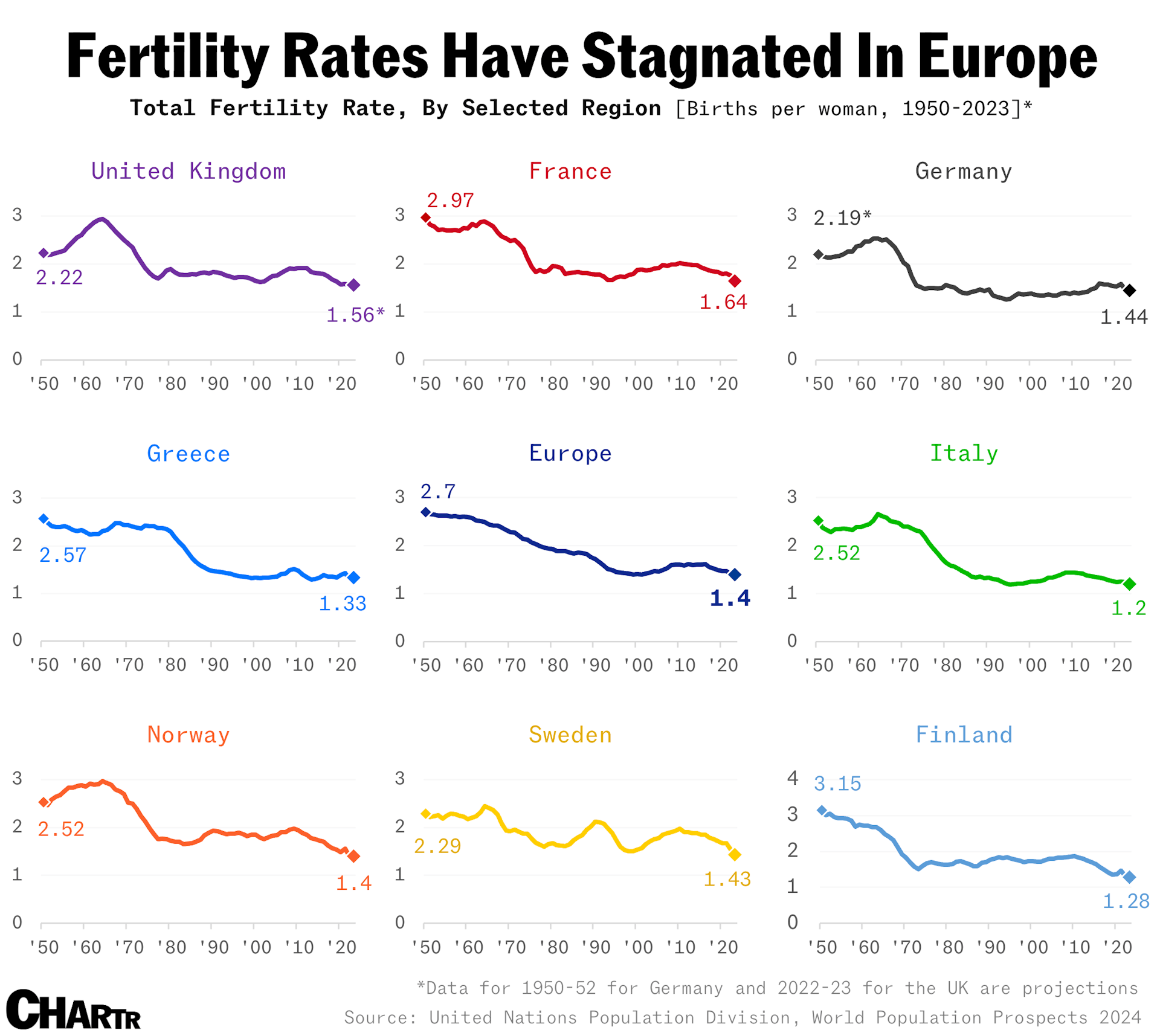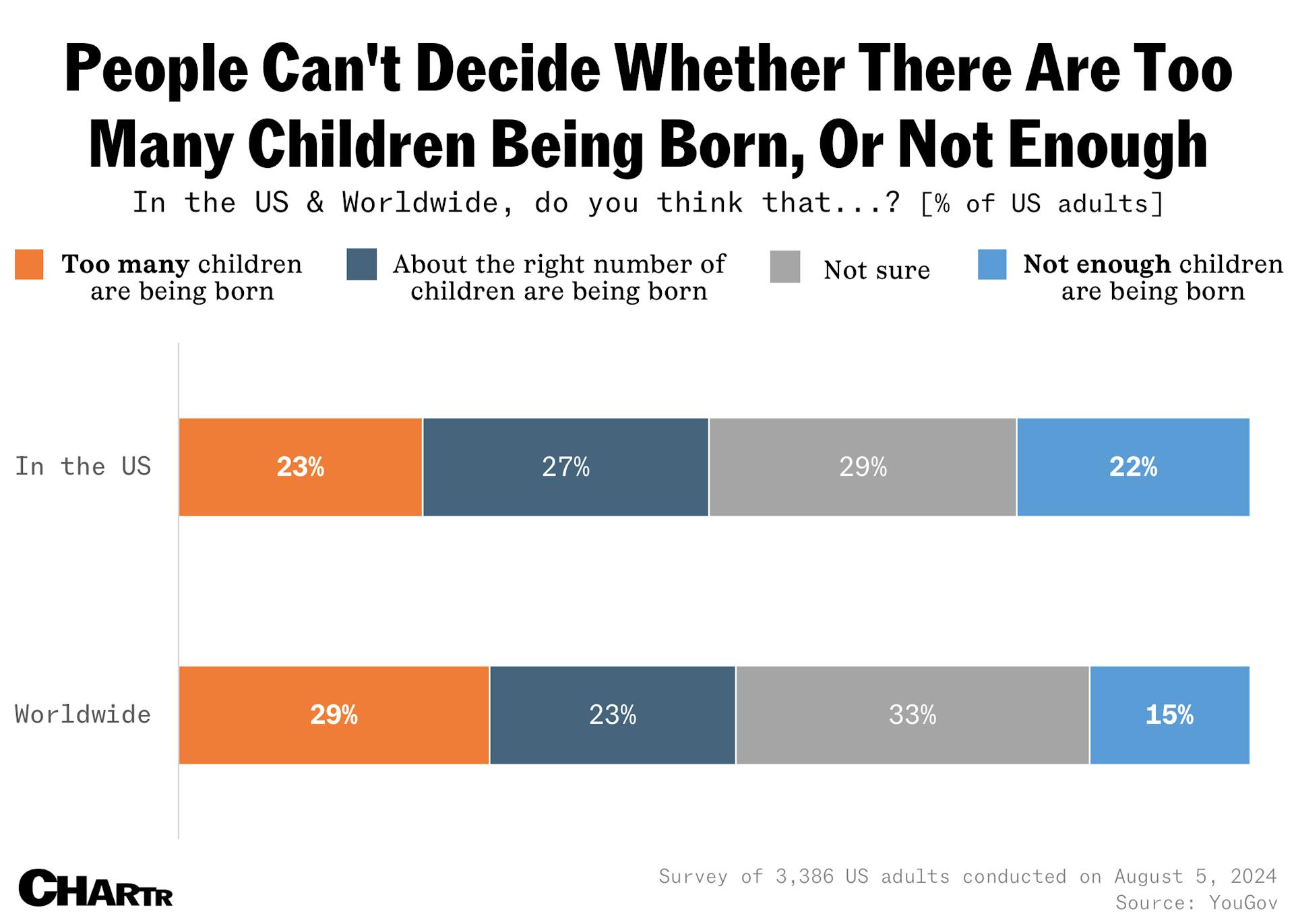Why aren’t people having babies?
Cutting across language, geography, and culture, one societal trend is beginning to loom larger than any other: falling birth rates.
For a large part of the last century, after a post-war baby boom saw 76 million births over just 18 years in the US alone, fears of overpopulation were rife.
In 1968, Stanford entomologist Paul Ehrlich published the landmark book “The Population Bomb,” which posited that overcrowding was not only the cause of many of the era’s issues, but would eventually lead to dystopian outcomes of famine, pollution, ecological disaster, and possibly even societal collapse.
Per Vox, it took the human population hundreds of thousands of years to hit its first 1 billion (in the year 1800); it took 128 years to hit the 2 billion mark; then just 32 years to add the next billion (1960). Cut to the present day and there are ~8.2 billion people in the world, and counting. While Ehrlich may have been onto something, the “bomb” he predicted never exploded. In fact, what we’re currently seeing is closer to an implosion. Now, in nearly every developed country in the world, birth rates are plummeting.
Baby bottleneck
The global total fertility rate — measured as the average total number of births per woman (if she lives to the end of her child-bearing years) — has more than halved since 1970 to just 2.25 in 2023, according to the World Population Prospects 2024 from the United Nations. The replacement rate, or the birth rate theoretically required for a natural population to replace itself from one generation to the next, is generally accepted to be ~2.1 births per woman. Any higher than this and the population grows; any lower than this and the population shrinks.

The UN report, published in July, stated that overall, “Women today bear one child fewer, on average, than they did around 1990,” and projected the world’s population to peak at about 10.3 billion in the mid-2080s before starting to gradually decline.
So, for now, the global population is still growing. But that worldwide viewpoint masks what is expected to be a very different experience from country to country. Indeed, The Lancet estimated that, by 2050, more than three-quarters of countries worldwide will not be able to sustain their population size over time. Let’s look at some specific cases, starting with the United States.
Here’s looking at you, kids
America’s total fertility rate hasn’t been at the replacement level of 2.1 since 2007, after peaking in the late ’50s during the baby boom, and stood at 1.62 in 2023, by the UN’s count.
Though people do tend to have fewer kids when economic times are tough, it’d be hard to blame the baby shortage on the inflation woes of the last few years, considering that this trend has been decades in the making. More significant, it seems, is the impact of social change on the American public’s proclivity for having kids. Since the 1970s, women’s liberation, equal education, and access to contraception have generally improved in the US, and more women in the workforce means that motherhood typically carries a steeper personal financial penalty.
A White House report from May cited increases in female labor-force participation as one way the US hopes to offset the economic impacts of an aging population.
The role of the American family unit is likely to be a key presence in the minds of voters in the upcoming US presidential election, as opposing stances on reproductive rights, as well as comments about “childless cat ladies,” have made headlines. But the issue is even more pressing in Europe, where the average fertility rate fell to just 1.4 last year, per the UN — well below the replacement level.
Eurotots
Much like the US, the effects of higher parenting costs, changing social structures and attitudes, lost earnings time, and squeezed disposable incomes are playing out across Europe. With an ultralow fertility rate of 1.2 recorded in 2023, Italian Prime Minister Giorgia Meloni has said that raising the country’s birth rate is a “top priority.” Earlier this week, the UK’s Office for National Statistics reported that deaths outpaced births in the country for the first time in almost 50 years. A recent Guardian article told of villages in Greece where a single birth hasn’t been seen in years.

Nordic countries like Sweden and Finland were long upheld as the gold standard in baby-boosting government practices. Pro-natal policies — like better parental leave, strong welfare services, and childcare support — formed part of the social-policy system known as “the Nordic model,” and these incentives for child-rearing led to a baby bump in Sweden in the early 1990s. But now, even these countries are seeing birth rates slump below replacement level.
In an interview with the Financial Times in January, Finnish demographer Anna Rotkirch outlined that, in spite of government incentives, having children can fall to the wayside of other opportunities for many Nordic adults:
“In most societies, having children was a cornerstone of adulthood. Now it’s something you have if you already have everything else. It becomes the capstone.” — Anna Rotkirch
Cross-cultural
What’s so striking about the fertility decline is how widespread it is — it’s not bound by language, culture, or geography, and the speed of the shift has caught governments off guard. Take China as an example. For a long time the world’s most populous country, China embarked on a demographic experiment the scale of which the world had never seen before, rolling out the infamous one-child policy in 1980 in a bid to curb its soaring population.
Now, China has a new population problem. The fertility rate in mainland China is projected to have fallen to about one birth per woman in 2023, less than one-seventh of what it was at its 1963 peak. Not just this, but The New York Times reported this week that alongside “carrot” policies like free college, tax breaks, and IVF support, the Chinese government is also rolling out a “stick” fertility campaign, including knocking on doors and installing pro-family artwork in public places.
Conti-natal drift
The situation in other East Asian countries is compounded by rapidly graying demographics, with some young people citing the added burden of looking after elderly relatives as a barrier to them starting a family. In Japan, where more than 1 in 10 people are aged 80+ years, adult diapers are close to outselling baby diapers, and politicians are scrambling to enact fertility programs. Singapore is encouraging companies to hire older workers after estimates put its total fertility rate below 1.0 in 2023 for the first time ever.

But nowhere is this issue more extreme than in South Korea, which has the lowest fertility rate in the world, reported as just 0.72 last year. Since 2006, its government has tried to address the issue by spending over 360 trillion won ($270 billion) on pro-natal schemes; however, astronomical housing costs, the worst gender pay gap in the OECD, and a mounting anti-marriage counterculture mean that it’s still on track for the country’s population to halve by 2100.
One significant exception to this global trend is Africa, where birth rates remain high. It’s estimated that countries in sub-Sarahan Africa, like Niger and Angola, will contribute over half (55%) of the world’s births by the end of the century. Indeed, as fertility rates fall pretty much everywhere else, Africa’s population is set to double by 2050, according to The Economist.
Twin ideas
Interestingly, as birth rates plummet, the general public can’t decide on whether it’s a bad thing or not. A recent YouGov survey revealed a startling split: 22% of Americans said they didn’t think enough children were being born, while 23% said there were too many.

Economists, on the other hand, are a little more one-minded on the issue, as falling fertility rates spell only one thing in the future: a smaller number of working-age people supporting a larger number of older citizens.
For decades, population growth has been a tailwind to economic growth; in the future, population declines will be a headwind, and one that hits many of the wealthiest countries at the same time. Furthermore, unless these trends are reversed, they will last indefinitely. If a country’s birth rate stays below the threshold at, say, 1.5, it doesn’t mean we go through a few generations of having more old people than young people before reaching a steady state — it means a shrinking population into perpetuity.
The parent trap
While recognizing and addressing fertility issues on a national level can help to avoid extremely low birth rates, in nearly every case — from the US, to Europe, to Asia — interventions to try to make people want to have children seem to eventually fail in the long term.
Today, there’s a growing trend of child-free lifestyles, appealing for some for personal, political, or environmental reasons. One Pew Research study published in July found that 38% of adults aged 18-49 who reported being unlikely to have children cited “the state of the world” as a major reason why, with 26% citing environmental concerns. However, most just said the simplest answer: they didn’t want them.

Ok, buster
Economists have postulated other solutions to the global fertility crisis, including large-scale immigration and promoting longer-term employment. At this rate, though, it seems that a future with fewer young people is difficult to avoid, unless Gen Z decides en masse that procreation is cool.In generations to come, maybe automation and other forms of AI can help make up for a lack of employees on company floors. That’s not the weird dystopian thing that Ehrlich predicted, but hey, it’s the weird dystopian thing we got.